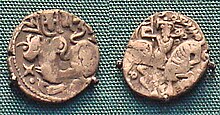This article has multiple issues. Please help improve it or discuss these issues on the talk page. (Learn how and when to remove these template messages)
This article is an orphan, as no other articles link to it. Please introduce links to this page from related articles; try the Find link tool for suggestions. (December 2021)
This article may be confusing or unclear to readers. Please help clarify the article. There might be a discussion about this on the talk page. (December 2021) (Learn how and when to remove this template message)
(Learn how and when to remove this template message)

The coins of Mahmud Ghazni struck in India with Arabic and Sanskrit legends on obverse and reverse respectively, show a number of varieties in so far as the legends, the dates and the lettering and its arrangements are concerned.[1]
Ghaznavid control largely continued in the existing administrative system. Thus Ghaznavid coins issued in North western India have bilingual legends written in Arabic and Sharda scripts . Some carry Islamic titles together with the portrayal of the Shaiva Bull, Nandi and the legend Shri samta deva. The reference in the latter remains ambiguous . A dirham struck at Lahore carries a legend in the Sharda script and a rendering in colloquial Sanskrit of the Islamic Kalima.[2][3]